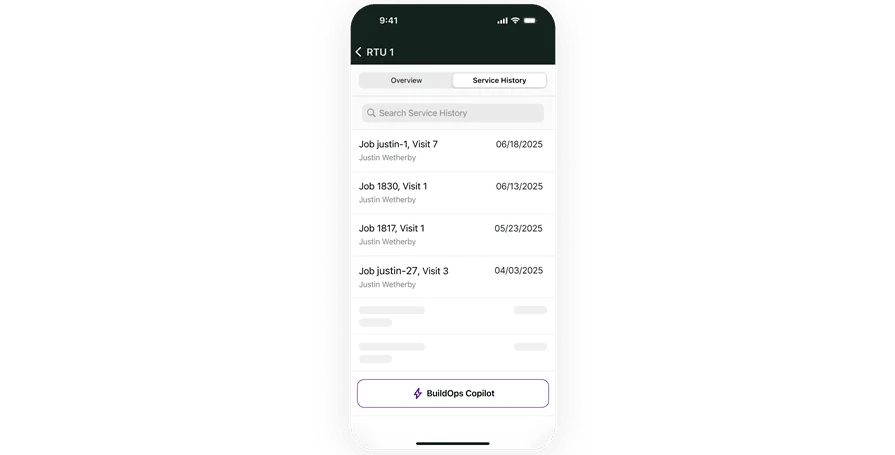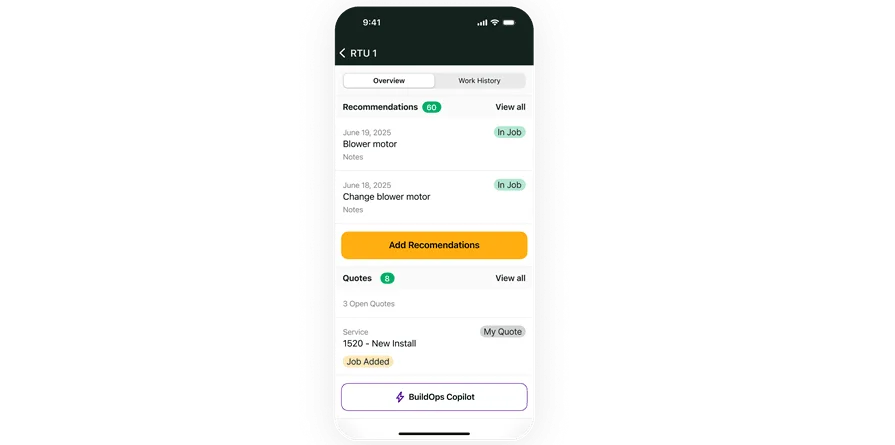Keeping up with field work in commercial trades shouldn’t feel like constant guesswork. When your crew’s in the thick of HVAC installs, electrical repairs, or plumbing emergencies, the last thing you need is a gap between the field and the office.
That’s where a solid fieldwork app proves itself. It keeps your team connected, jobs logged, and updates flowing—without your techs needing to chase down paper forms or dial in for basic info. If your crews rely on manual tools or a patchwork of apps, it’s worth exploring how a field work app can bring it all together. This guide breaks down how the right fieldworker app improves accuracy, shortens job cycles, and keeps your team moving. For those already diving into field service management, this is the hands-on tool that supports every step technicians take on-site. Here’s what we’re covering:
- Choosing a field work app that fits your crew's daily flow
- 6 key features every fieldworker app should include
- Types of apps for field work by trade and team setup
- 6 best field work apps for contractors in the field
- 7 real-world benefits of using a fieldwork app
- 4 FAQs from field teams before committing to a field work app
Let’s walk through how a strong app for field work transforms job sites into smooth, trackable operations—and helps your crew spend less time waiting and more time working.
Choosing a field work app that fits your crew's daily flow
A fieldwork app should work like an extra crew member—silent, reliable, and always one step ahead. For techs out in the field, whether they're replacing HVAC units, fixing electrical faults, or inspecting fire safety systems, the app they carry isn’t just another tool—it’s the command center in their pocket.
The choice of app matters because it directly affects how fast your crew can get work done, how clearly they can communicate with the office, and how accurately jobs get documented. A field work app needs to move at the pace of the worksite—fast, responsive, and built to keep your techs focused on the job, not the screen.
Before locking one in, here’s what to look for:
- Ease of use in the field - Can your techs figure it out without a manual? Does it reduce confusion when they’re switching between tasks or sites? Will they need to stop and call the office just to pull up a job detail or checklist?
- Mobile-first access - Will the app perform under weak signal conditions? Does it load quickly and run smooth on both Android and iOS? Was it designed specifically for phones, or does it just feel like desktop software crammed onto a small screen?
- System integration - Can it pull job history and customer data from your CRM? Will it sync with your accounting or scheduling tools? Does it automatically update the office when a tech finishes a task or logs a new issue?
- Data security and user access - Is the data encrypted? Can you restrict what techs, supervisors, or admins can see and do? What’s the process if someone loses a device—can you lock access immediately?
- Features - Does the app for field work support photo uploads, digital signatures, and checklists? Can techs close out jobs from the field, log materials used, or flag issues for follow-up? Is everything logged in real time so nothing gets missed?
These are the decisions that matter before diving into bells and whistles. Up next, we’ll break down the key features every fieldworker app should bring to the job site.
6 key features every fieldworker app should include
A reliable field work app should feel like a core part of your operation—simple to use, responsive in real time, and capable of supporting your team across every job type and location. Whether you’re managing HVAC installs, handling urgent electrical repairs, or running multi-site inspections, the app has to meet the pace and pressure of daily field service work.
These features keep crews in sync, help close out jobs faster, and give your office the visibility it needs without chasing updates.
1. Real-time scheduling and dispatch
The moment plans shift, your team needs to know. A field work app with real-time scheduling tools lets you update assignments and reroute crews on the fly. Pair it with a dispatching solution built for field contractors and you can match the nearest tech with the right skills to each job—fast. Let’s say your refrigeration tech finishes a walk-in cooler repair ahead of schedule. Dispatch sees the availability, assigns them to a service call nearby, and the tech receives the job details before even getting back in the van.
2. Built-in invoicing and payment
Work completed means payment captured. When your techs can generate invoices through the invoicing feature in your field app and collect payment using built-in payment tools, you cut billing delays and improve cash flow immediately. Think about a plumbing crew handling a weekend call. They wrap up the work, itemize the repair, and collect payment right on the job site—no need to follow up later or wait for office processing.
3. Access to CRM and job history
Your techs should never walk in blind. With CRM functionality inside your field work app, they can review equipment history, previous issues, and customer preferences before they even show up. Picture your HVAC technician rolling up to a hospital job. Before checking in at the front desk, they’ve already pulled the last three service visits, identified known equipment quirks, and seen who to ask for onsite. No guesswork—just a smooth start.
4. Fleet and vehicle tracking
The field is always moving. A fleet management view inside the app gives dispatchers the full picture—where trucks are, who's on the road, and how long until they hit the next job. Say your electrical crew gets tied up in traffic after a citywide outage. The system flags the delay, reroutes a closer tech to an open service ticket, and alerts the customer with an updated ETA—all without needing a phone call.
5. Quoting from the field
Every service call is an opportunity to identify future work. A quoting feature made for field teams allows techs to build clear, professional estimates on-site. Link that with a live pipeline of open opportunities and you’ve got a tool that turns walk-throughs into revenue. Say, for instance, during a maintenance visit, your technician spots a failing rooftop unit. They enter the details, take a photo, and send a quote before they leave the building—keeping the conversation alive without delay.
6. Job performance reporting
You can’t adjust what you can’t see. A fieldworker app with real-time reporting tools helps you monitor response times, time-on-site, and team workloads. Instead of reacting to problems late, you get the data to stay ahead. For example, if you notice one crew consistently logging longer hours on similar jobs, the data shows where bottlenecks are happening—giving you a clear path to adjust routes, support, or scheduling.

Explore our mobile tech app
The BuildOps app puts every feature in your techs’ fingertips.
Other useful features for field work apps
Some features operate behind the scenes but still make a big difference across the job cycle. These tools help field teams stay organized, reduce back-and-forth with the office, and keep your systems clean from job intake to closeout. When built into a field work app, they support smoother operations—especially for growing teams or contractors managing recurring work, reporting, and labor tracking at scale.
While these tools don’t carry the same daily weight as the top six features, they bring added value and help tighten up your operation from the field all the way to the office.
- Service agreement tracking - For contractors handling recurring maintenance, automated service agreement tools inside the app ensure no visit gets missed. The system logs contract terms, service intervals, and site notes—keeping techs aligned with what’s due and what’s already been handled.
- Time tracking for job costing and payroll - A field-ready time tracking feature makes logging hours straightforward for techs and crystal clear for payroll. No separate apps, no paper logs—just clock in, clock out, and tag time to the right job or cost code.
- Organized data for job reports and forecasting - With historical data driving future decisions, a clean flow of info through your reporting system helps flag bottlenecks, predict job duration, and fine-tune your field strategy. It’s especially useful for managers handling dozens of crews and projects at once.
These tools enhance what your field work app already delivers—and make sure the office and job site stay on the same page.
Types of apps for field work by trade and team setup
The way your crews handle field work—how they move, communicate, and close out jobs—should shape the kind of app you put in their hands. Choosing an app for field work means thinking about how your team operates day to day. Are they moving between commercial high-rises, handling residential calls, or juggling both? Is your team spread across regions, or reporting back to a single location?
The tools that work for a tight-knit five-person crew won’t always work for a company managing 30 trucks and multiple trades. Here are the most common types of field work apps to consider:
- Office-based platforms - These systems are built for fixed locations—typically installed on desktops or local servers. They suit operations with in-house scheduling and limited field mobility. Contractors who rely heavily on back-office staff to direct techs often use these setups. But for on-the-go teams, they don’t offer the flexibility required when jobs change by the hour.
- Web-based field apps - Web apps live in the cloud and run through any browser. Crews and office staff can access schedules, job data, and updates from any connected device. These are a solid fit for teams that move fast, handle multiple locations, and rely on real-time visibility between office and field.
- Mobile-native field apps - Designed specifically for mobile phones and tablets, these apps give techs everything they need on the go—job notes, checklists, customer info, and updates—all from a single place. There’s no need for laptops or paperwork. These work best for crews that spend the majority of their day in the field. Some may come with fewer admin features, but they’re built for speed and responsiveness on-site.
Each setup has strengths depending on how your business runs. For contractors balancing admin needs with full field mobility, mobile-friendly web apps often deliver the best of both—visibility, flexibility, and control without dragging the team down.
6 best field work apps for contractors in the field
Choosing a field work app goes beyond checking off features—it’s about finding a tool that actually fits how your crews move, communicate, and complete jobs in the field. The right platform supports fast decision-making, keeps your techs informed, and helps your office track work without extra hassle.
Here are six options that stand out for different types of contractors—commercial, residential, and mixed trades—each with unique strengths depending on your operation.
1. Best for commercial contractors: BuildOps
BuildOps is a field work app tailored for commercial contractors managing large-scale projects, complex scheduling, and multiple service types. Techs use a mobile app that puts job notes, service history, photos, and checklists at their fingertips. Dispatchers handle assignments through a live board with GPS visibility, making job changes quick and seamless. From quoting to invoicing, everything ties together in one platform built for the field.
App Type: Cloud-based platform with mobile technician access
How Pricing Works: BuildOps offers weekly live demos and custom walkthroughs to match business needs
Key Features:
- Mobile access to job details, service history, and checklists
- Live drag-and-drop scheduling and job reassignment
- Centralized customer and equipment records
What Sets It Apart for Commercial: BuildOps supports job coordination across large crews and multiple sites while linking every job detail back to CRM, quotes, and schedules—all inside a single system.

See how the BuildOps app works
Office and field in constant contact to complete jobs faster with less admin.
2. Best for residential contractors: Housecall Pro
Image Source: Housecall Pro
Housecall Pro is a field work app designed with residential contractors in mind. It offers a clean calendar view, job tracking, and a customer portal for service requests. Techs can send updates, receive reminders, and access job info from their phones, which helps simplify operations for home services like HVAC, plumbing, and electrical. The app is lightweight and quick to set up for teams that want to get moving fast. It may fall short for commercial contractors needing detailed controls or advanced reporting.
App Type: Cloud-based platform with mobile access
How Pricing Works: Housecall Pro offers tiered pricing depending on business size and feature access.
Features Beyond the Basics:
- Text updates and customer communication tools
- Online booking and customer scheduling
- Real-time tech tracking during jobs
What Sets It Apart for Residential: Housecall Pro gives residential crews simple, efficient access to jobs and customer details, helping them stay on top of service calls without needing office support.
3. Best for general contractors: Jobber
Image Source: Jobber
Jobber works well for contractors managing a mix of job types—from residential service calls to larger installations. It combines a visual scheduling calendar, client records, invoicing, and route optimization into a single platform. Teams get alerts, job updates, and reminders right from the app, helping to keep field and office operations connected throughout the day. This solution can feel limited for high-volume teams needing deeper customization or multi-division workflows.
App Type: Web-based with mobile technician access
How Pricing Works: Monthly plans based on features and team size
Features Beyond the Basics:
- Route tracking and GPS job alerts
- Job quoting and invoice generation
- Customer profiles with service history
What Sets It Apart for General Contractors: Jobber is flexible enough for mixed trade teams who want a balance between admin tools and fast-moving field access.
4. Best for growing service teams: FieldEdge
Image Source: FieldEdge
FieldEdge is a solid choice for field teams stepping up from spreadsheets or disconnected systems. It brings dispatching, customer management, invoicing, and mobile updates into one platform. Crews can view assignments, track job progress, and log service notes directly from the app. The dashboard helps office staff filter by skill set, location, and availability, making it easier to assign the right tech to each job. FieldEdge may feel limited for teams with unique workflows or larger-scale coordination needs.
App Type: Cloud-based with mobile technician access
How Pricing Works: Customized pricing based on team size and operational needs
Features Beyond the Basics:
- Flat-rate pricing integration and quoting tools
- Live job tracking and service history
- CRM features with asset-level visibility
What Sets It Apart for Growing Teams: FieldEdge helps service teams transition into mobile-first operations with tools that improve dispatch speed, billing accuracy, and job documentation.
5. Best mobile-first app for field crews: ServiceTitan
Image Source: ServiceTitan
ServiceTitan is designed to support small to mid-sized service teams that need full visibility without sacrificing field mobility. It gives techs access to job details, schedules, customer history, and payment tools right from their mobile device. Built-in messaging, GPS tracking, and offline capabilities help crews stay productive even in areas with weak signals. It’s especially useful for teams handling a high volume of jobs with a lean office staff. Smaller contractors looking for something lighter or quicker to roll out may find the system more involved than necessary.
App Type: Mobile-first platform with full back-office sync
How Pricing Works: Custom quotes based on feature set and number of users
Features Beyond the Basics:
- In-app messaging and job status updates
- Offline access for remote job sites
- Digital forms, customer signatures, and payment capture
What Sets It Apart for Small to Mid-Sized Teams: ServiceTitan gives crews everything they need to manage jobs from the field while keeping office staff looped in—ideal for growing contractors who want structure without slowing down.
6. Best for multi-trade contractors: Service Fusion
Image Source: Service Fusion
Service Fusion is built for contractors managing multiple trades—HVAC, plumbing, electrical, and beyond. It supports job scheduling, route planning, and technician dispatch across various service categories. Features like technician skill tagging and service zone mapping make it easier to assign jobs accurately and avoid overlap. The platform also includes customer communication tools, call tracking, and a mobile app for techs in the field. Teams requiring highly customized workflows or modern UI may find the interface dated in some areas.
App Type: Cloud-based platform with mobile technician access
How Pricing Works: Flat monthly pricing with no per-user fees
Features Beyond the Basics:
- Crew and role-based access controls
- Smart service zones and multi-trade job management
- Communication suite with integrated call tracking
What Sets It Apart for Multi-Trade Contractors: Service Fusion gives field teams clear visibility across different service types and job sites, helping contractors coordinate large crews without confusion.

Get the software scoresheet
Compare field service teams with this easy-to-use software scoresheet.
7 real-world benefits of using a fieldwork app
When the right field work app is in place, the payoff shows up fast—in how your crews work, how your office tracks progress, and how smooth the job cycle becomes from start to finish. These aren’t surface-level wins. They’re the kind of benefits that help contractors reduce downtime, build customer trust, and run a tighter, more profitable business. Here are seven ways a fieldwork app delivers real impact across your team and your operation.
1. Faster scheduling response times
When techs finish early or emergencies pop up, you need the flexibility to shift the schedule without losing a step. A solid fieldwork app helps your office reassign jobs instantly, keep techs in the loop, and avoid service gaps. With the help of field service scheduling tools, your crew spends less time waiting on instructions and more time moving from job to job.
2. Less driving, fewer missed jobs
A fieldwork app that shows where your team is and how far they are from upcoming jobs helps you tighten routes and reduce wasted fuel. Rerouting on the fly becomes easier, especially when techs are covering wide service zones. Tools that support smart field service routing decisions keep your fleet efficient and help avoid scheduling backups.
3. Fewer missed handoffs between field and office
When techs can enter job notes, attach photos, and flag follow-ups directly from the field, there’s no guessing later. You reduce repeat calls, cut out paperwork, and avoid delays caused by information slipping through the cracks. A well-integrated field service ticketing system makes it easy for teams to log and track all the details without chasing someone down.
4. Better visibility into technician performance
When job times, site check-ins, and closeout details are logged in real time, you can spot slowdowns before they stack up. This kind of field-level visibility helps identify overbooked techs, training gaps, or resource issues early. With reporting tools tailored to field service, managers can make smarter calls based on real data.
5. Cleaner dispatching without the chaos
Manual dispatching creates confusion—especially when job priorities shift mid-day. A fieldwork app with live updates keeps your team aligned without needing constant phone calls or calendar changes. Mastering field service dispatching helps you understand what a streamlined, tech-friendly dispatch process should look like—and how to avoid getting bogged down.
6. More consistent customer experiences
When updates, arrival times, and post-job notes all run through one system, customers don’t get left wondering. From automated reminders to job wrap-up follow-through, a reliable field app creates a smoother customer experience across the board.
7. Increased trust from the crew
When your techs have the right tools, it shows. A fieldwork app that works without crashing, gives them the info they need, and helps them close jobs faster builds confidence. The result is fewer mistakes, fewer complaints, and a team that feels supported instead of frustrated.
4 FAQs from field teams before committing to a field work app
Before rolling out a fieldwork app, most contractors hear the same set of questions from their techs—and for good reason. These apps are the lifeline between your crews and the office. For field service techs working job to job, the app they use needs to do more than store information. It should speed up their day, reduce back-and-forth, and help them wrap jobs cleanly. The goal is to make sure every fieldworker app fits into the real flow of field work—not just another system the crew has to learn.
Here are the four questions that come up most often.
1. What is a fieldwork app?
A fieldwork app gives contractors a way to assign jobs, track progress, and manage updates across their entire field team. It centralizes everything—job notes, customer details, photos, signatures, invoicing, checklists, and status updates—so field service techs and the office stay aligned.
For field service pros, it replaces paper forms, calls for updates, or checking in from a truck with a single app for field work they can rely on throughout the day.
2. Can a field work app work with the systems we already use?
Many apps are designed to connect with your current tools—whether that’s CRM, accounting software, or scheduling platforms. This type of integration makes it easier for techs to avoid double entry, while keeping everything flowing smoothly from dispatch to invoicing. If your systems are already working, the right field work app should plug into that setup, not replace it entirely.
3. Do my techs need to be trained on the fieldworker app?
If it’s well-designed, training should be minimal. Your techs should be able to open the app, check job details, navigate to a site, upload updates, and move to the next task without a call to the office. That said, it’s smart to give your field team a short walkthrough and time to ask questions—especially if they’re used to older systems or haven’t worked with mobile tools before.
4. What are the best practices for using a field work app?
Once the app is in your crew’s hands, using it the right way makes all the difference. Below are practical ways to get the most value out of a field work app:
- Assign a team lead to test and pilot the app before full rollout
- Make sure techs use the app to check in and out of every job site
- Upload job photos and tag them by location and service type
- Use checklist features to confirm work is complete before closeout
- Keep customer notes updated after every visit
- Report job status in real time so the office stays synced
- Save time by preloading repeat tasks and templates
- Sync job updates with invoicing to speed up billing
- Review completed work at the end of each day for accuracy
- Ask techs for regular feedback on what’s working inside the app
When the whole team follows the same steps, the fieldworker app becomes a tool that supports every job—not something that gets in the way.
Choosing a field work app shouldn’t feel like chasing the next shiny thing—it’s about giving your techs what they need to do the job right the first time. Whether they’re servicing rooftop units, handling emergency calls, or juggling multiple stops in a day, the app in their hands should help them move faster, communicate better, and close jobs with confidence.
For commercial contractors handling bigger workflows and high-volume teams, having an all-in-one platform matters. That’s where BuildOps fits in—bringing scheduling, dispatch, CRM, invoicing, and field access together into one system designed specifically for the kind of heavy-duty work you do.

Want to see BuildOps in action?
Connect teams in the field with the job details they need to get the task done.








